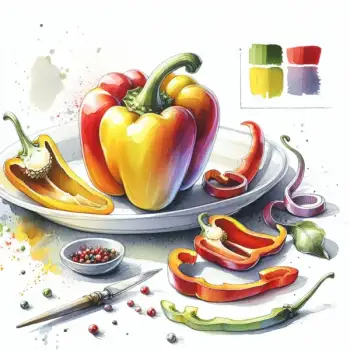


Dried
Dehydrated bell peppers, often found in spice aisles as flakes or powder, used to add a concentrated pepper flavor to dishes without additional moisture.
Fresh
Bell peppers come in various colors, including green, red, yellow, orange, and sometimes purple, brown, or black. Each color has a slightly different flavor profile, with green being the most bitter and red being the sweetest.
Frozen
Bell peppers that have been sliced and flash-frozen, convenient for out-of-season use or quick meal preparation without significant loss of flavor.
Pickled
Bell peppers that have been preserved in vinegar and spices, offering a tangy flavor suitable for sandwiches, salads, and as a garnish.
Roasted
Bell peppers that have been charred and peeled, offering a smoky flavor. They can be homemade or purchased in jars, often preserved in oil or brine.




dried bell peppers: Spice Supreme
frozen bell peppers: Birds Eye
pickled bell peppers: Vlasic
roasted bell peppers: Mezzetta

Grilling: Grilling bell peppers over high heat until charred imparts a smoky flavor. They can be grilled whole, in halves, or in large pieces. After grilling, you can peel them or use them as is, depending on the recipe and desired texture.
Roasting: Roasting bell peppers until their skins blister makes them sweet and tender. This is often followed by placing them in a covered bowl or a bag to steam, which makes peeling the skin off easier. Roasted peppers can be used in a variety of dishes, from salads to sandwiches.
Sautéing: Sautéing diced or sliced bell peppers in oil over medium heat enhances their natural sweetness and is a quick way to prepare them for stir-fries, fajitas, and other dishes. They should be sautéed until just tender to maintain some of their crispness.



